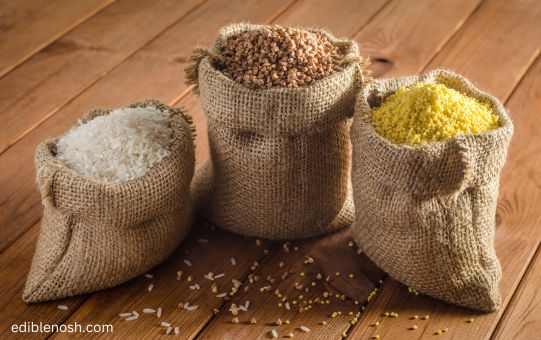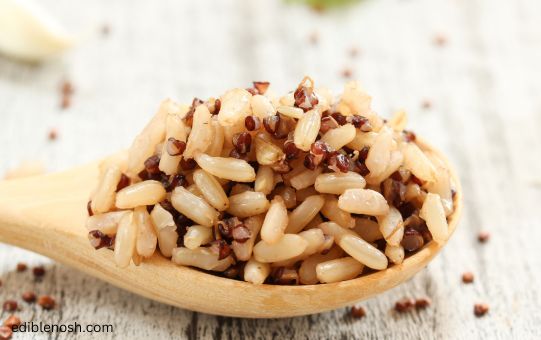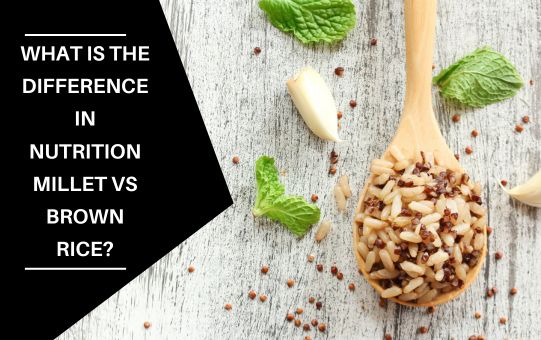While finding the healthy grains difference in nutrition millet vs brown rice getting more popular due to its plenty of health benefits. Both of these grains are wholesome alternatives to refined carbohydrates.
What is the difference in nutrition millet vs brown rice? Millet and brown rice both are enriched with plenty of healthy carbohydrates. Also While they share similarities, there are distinct differences in their nutritional composition, taste, and culinary applications.
Lets dig in the article for the disparities between millet vs brown rice, uncovering their unique nutritional profiles and how they impact our health.
Contents
What is the difference in nutrition millet vs brown rice?
Millet and brown rice differ in terms of their nutritional composition. Millet, which encompasses a variety of small-seeded grasses, is rich in nutrients such as magnesium, phosphorus, and B vitamins.
It is a good source of dietary fiber, providing a substantial amount that aids in digestion and promotes a feeling of fullness. Additionally, millet is gluten-free, making it suitable for individuals with gluten sensitivities or celiac disease.
On the other hand, brown rice, which is a whole grain rice with the bran and germ intact, is also packed with essential nutrients. It contains a higher amount of dietary fiber compared to white rice, offering improved digestion and potential blood sugar management.
Brown rice is a good source of manganese, selenium, and magnesium, as well as vitamins B1, B3, and B6. It is a healthier alternative to white rice due to its higher nutrient content and lower glycemic index.

Nutrition Content of Millet
Millet is a small-seeded grain that has been cultivated for thousands of years. It comes in various varieties, such as pearl millet, foxtail millet, and finger millet. When it comes to nutrition, millet offers several key benefits.
Vitamins and Minerals
Millet is a rich source of essential vitamins and minerals. It contains significant amounts of magnesium, phosphorus, and manganese, which play vital roles in bone health, energy production, and antioxidant function.
Additionally, millet provides B vitamins, including niacin, thiamin, and riboflavin, which are essential for metabolism and overall well-being.
Fiber Content
Fiber is crucial for a healthy digestive system, and millet is abundant in dietary fiber. It promotes regular bowel movements, prevents constipation, and supports gut health.
The fiber in millet also aids in maintaining stable blood sugar levels, making it an excellent choice for individuals with diabetes or those seeking blood sugar control.
Protein Content
Despite being a grain, millet boasts a considerable protein content. It contains essential amino acids, making it a valuable source of plant-based protein. Protein is vital for building and repairing tissues, supporting immune function, and providing sustained energy.
Nutrition Content of Brown Rice
Brown rice is a whole grain that retains its bran and germ layers, unlike refined white rice. Let’s explore its nutritional aspects.
Vitamins and Minerals
Brown rice is packed with essential vitamins and minerals, making it a nutritious option. It contains notable amounts of manganese, selenium, and magnesium, which contribute to various bodily functions.
Additionally, brown rice is a good source of B vitamins, such as thiamin, niacin, and vitamin B6, which are vital for metabolism and overall health.
Fiber Content
Similar to millet, brown rice is a significant source of dietary fiber. This fiber aids in maintaining regular bowel movements, reducing the risk of constipation, and promoting a healthy digestive system. The fiber content in brown rice also helps in managing weight by providing a feeling of fullness.
Protein Content
While not as high as millet, brown rice still contains a notable amount of protein. Protein is crucial for numerous bodily functions, including muscle repair, hormone production, and enzyme synthesis.
Brown rice can contribute to a well-rounded protein intake, especially when combined with other protein sources in the diet.
Glycemic Index and Blood Sugar Impact
The glycemic index (GI) measures how quickly carbohydrates in food raise blood sugar levels. Both millet and brown rice have relatively low GI values compared to refined grains, making them suitable choices for individuals concerned about blood sugar control.
However, millet has a lower GI than brown rice, indicating a slower and more gradual increase in blood sugar levels after consumption.

Health Benefits of Millet
Millet offers a range of health benefits beyond its nutritional value. Let’s delve into some of these advantages.
Digestive Health
The high fiber content in millet promotes healthy digestion by preventing constipation, improving bowel regularity, and supporting a balanced gut microbiome. It can alleviate digestive issues and contribute to overall digestive well-being.
Heart Health
Millet contains nutrients like magnesium, which plays a vital role in maintaining heart health. Adequate magnesium intake has been associated with a reduced risk of cardiovascular diseases, including heart attacks and strokes. Incorporating millet into a heart-healthy diet can be beneficial for cardiovascular well-being.
Weight Management
As a nutrient-dense grain with ample fiber and protein, millet can aid in weight management. Its fiber content promotes satiety, reducing the likelihood of overeating. Furthermore, the protein in millet supports muscle maintenance and energy balance, contributing to a healthy body weight.
Health Benefits of Brown Rice
Brown rice, too, provides various health benefits. Let’s explore some of them.
Digestive Health
The fiber in brown rice aids in regulating bowel movements and preventing constipation. It supports a healthy digestive system, ensuring the efficient absorption and elimination of nutrients. Incorporating brown rice into the diet can promote digestive well-being.
Heart Health
Brown rice contains substances like lignans and antioxidants that contribute to heart health. These compounds help reduce the risk of heart disease by combating oxidative stress and inflammation. Consuming brown rice as part of a balanced diet can support cardiovascular well-being.
Weight Management
With its fiber content and low-calorie density, brown rice can be an excellent addition to weight management plans. The fiber promotes satiety, curbing hunger and reducing the likelihood of overeating. By incorporating brown rice into balanced meals, individuals can support their weight management goals.
Taste and Culinary Uses
Millet and brown rice differ in taste and culinary applications. Millet has a slightly nutty flavor, while brown rice has a chewy texture and a more earthy taste. Millet is versatile and can be used in porridges, salads, pilafs, and even as a gluten-free flour substitute. Brown rice is commonly used in stir-fries, rice bowls, sushi, and as a side dish to various cuisines.
Difference Between Nutrients Millet and Brown Rice
| Millet | Brown Rice | |
| Origin | Millet is a small-seeded grain that has been cultivated for thousands of years. | Brown rice is a whole grain that retains its bran and germ layers, unlike refined white rice. |
| Nutritional Composition | – Rich in vitamins and minerals, including magnesium, phosphorus, and B vitamins. <br> – Contains significant amounts of dietary fiber. <br> – Provides a notable amount of plant-based protein. | – Packed with essential vitamins and minerals like manganese, selenium, and B vitamins. <br> – Considerable dietary fiber content. <br> – Contains a notable amount of protein. |
| Glycemic Index | Millet has a lower glycemic index compared to brown rice, leading to a slower and more gradual increase in blood sugar levels after consumption. | Brown rice has a slightly higher glycemic index compared to millet, resulting in a relatively faster increase in blood sugar levels after consumption. |
| Health Benefits | – Supports digestive health and bowel regularity. <br> – Promotes heart health and aids in weight management. | – Aids in maintaining digestive health and a healthy gut. <br> – Contributes to heart health and assists in weight management. |
| Taste and Culinary Uses | Millet has a slightly nutty flavor and can be used in porridges, salads, pilafs, and as a gluten-free flour substitute. | Brown rice has a chewy texture and an earthy taste, commonly used in stir-fries, rice bowls, sushi, and as a side dish. |
Conclusion
Both millet and brown rice offer exceptional nutritional value and health benefits. Millet stands out with its higher protein content, lower glycemic index, and unique advantages like supporting digestive health.
Brown rice, on the other hand, provides a range of essential nutrients, aids in digestive health, and contributes to heart health. Ultimately, incorporating a variety of whole grains into your diet can provide a diverse array of nutrients and enhance overall well-being.
FAQs
Is millet gluten-free?
Yes, millet is naturally gluten-free, making it a suitable option for individuals with gluten sensitivities or celiac disease.
Can millet and brown rice be included in a weight loss diet?
Both millet and brown rice can be included in a weight loss diet due to their fiber content and ability to promote satiety. However, portion control and overall calorie intake should be considered.
Are millet and brown rice suitable for individuals with diabetes?
Yes, both millet and brown rice have a low glycemic index, which means they have a lesser impact on blood sugar levels. However, portion sizes and individual blood sugar responses should be monitored.
Can millet and brown rice be cooked together?
Yes, millet and brown rice can be cooked together to create a nutritious and flavorful blend. Adjusting cooking times and liquid ratios may be necessary.
Are there any potential allergens in millet and brown rice?
Millet and brown rice are generally well-tolerated and not common allergens. However, individual allergies or sensitivities should be taken into account.
Read Also>>>

